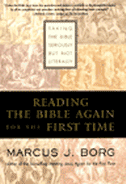READING THE GOSPELS AGAIN
The Hebrew Bible was the sacred scripture
used by Jesus and the early church. The majority
of Christians were probably Jewish until
the middle of the second century. The majority
of Jews did not live in the Jewish homeland
itself, but were part of the diaspora who
dwelt in many parts of the known world. Many
of the Christian churches originated in these
dispersed Jewish communities. We understand
the New Testament best when we see it within
the world of first-century Judaism.
The Christian scriptures were profoundly
influenced by the Hebrew Bible. The four
gospels are foundational to an understanding
of Jesus, even though Pauls genuine letters
predated them. They originated as anonomous
documents. Names were only given to them
later. The gospels and Pauline letters became
part of the developing Christian tradition.
Elements of both the historical
Jesus
(the human Jesus) and the canonical
Jesus
(the formal Jesus known by the early
church)
are found in the gospels. There are
therefore
both literal and metaphorical elements
to
the gospels. Both forms are legitimate
and
helpful to come to understand. We lose
much
of the value of the gospels if we read
them
as either literal or metaphorical.
There
are elements of both contained there.
The Canonical Jesus
We will focus on the canonical Jesus
to help us learn to understand the gospels
in the form we have them as the primal narratives
of the early church.
Each of the gospels has its own
unique
thematic construction. The first three
-
Matthew, Mark and Luke - are known
as the
synoptics (seen together) because they
are
similar in many ways. Matthew and Luke
borrowed
heavily from Mark, and added an early
collection
of Jesus' teachings known as 'Q'. This
source
is known to us only through its use
by the
two gospel writers. John is different,
and
stands apart.
Mark
Mark has a strong focus on apocalyptic
eschatology. That is, it deals with 'end
times' which its author and early readers
understood to be associated with the destruction
of the temple in 70 AD. Mark also introduces
Jesus' message that 'the kingdom of God'
was coming soon. People were encouraged to
follow 'the way' of this kingdom which Jesus
came to innaugurate.
Matthew
Matthew was written later than
Mark
and is the most Jewish as well as the
most
hostile to Judaism. The school which
Matthew
represented was that of a 'Christian'
Judaism
which survived the temple destruction
but
which was rejected by those of the
Jewish
tradition who did not accept Jesus
as Lord.
Matthew goes to great lengths to demonstrate
that even though his community follows
Jesus,
they remain in continuity with traditional
Judaism. So there is a kind of 'love-hate'
relationship going on here. Matthew
portrays
Jesus as a great teacher and prophet
in the
tradition of Moses. Matthew also provides
much of the material later used by
Christians
against the Jews. Matthew represents
an early
stage in the 'parting of the ways'
between
Christianity and Judaism, but for Matthew
and his community it was still an intra-Jewish
struggle.
Luke-Acts
Luke is a complement to Matthew
and
focuses primarily on the church in
Jerusalem.
Acts tells the story of the spread
of the
church to the Gentiles. Luke and Acts
make
much of the promise of the Spirit of
God
which would guide the church after
Jesus
had departed. There is much symbolism
in
the Spirit stories. The Spirit which
was
active in Jesus continues in the mission
of the community which, by implication,
is
called to continue Jesus' mission in
the
world.
John
John is distinct from the other
gospels
in many ways. His chronology of Jesus'
life
is different. So also is the main territory
in which Jesus ministered; his message
and
the style of his teaching. John is
the most
symbolic of the gospels. In John, Jesus
reflects
certain signs and wonders that demonstrate
his power and help people to believe
that
he is the Messiah.
Metaphor
John contains both intrinsic and historical
metaphor.
Intrinsic metaphor is a shorthand for metaphorical
meaning intrinsic to the story itself. Words
have special associations for those who know
them. Historical metaphor is a shorthand
for the additional metaphorical meanings
that flow out of the specific historical
associations of the language. The intrinsic
metaphor of the wedding at Cana story is
that the wine never runs out. The historical
metaphor relates to the special meaning of
'banquet' and 'marriage' in Judaism and early
Christianity.
Borg unpacks these two uses of metaphor
with references to Jesus walking on water,
feeding the multitude, giving sight to the
blind and describing himself as 'the way'.
The gospel portraits of the canonical
Jesus (the Jesus of the early church) make
extraordinary claims about him. He is one
with God. He is the revelation of God. He
is 'the way'. He is the bread of life. He
lifts us out of death into life. He is the
Word and Wisdom of God embodied in a human
life. He is the disclosure of what a life
full of God - a life filled with the Spirit
- looks like.
Who Is Jesus For Us?
This is what Jesus means for us as
Christians. Some modern Christians view this
as triumphalism and find these words 'exclusivistic'
in comparison to other faith traditions.
But for Christians, these claims should not
be watered down. We can say "This is
who Jesus is for us"without saying"And
God is known only in Jesus"
The gospels are Christianity's primal
narratives. These are the most important
stories of Jesus that we know, and we know
them to be decisively true. |



